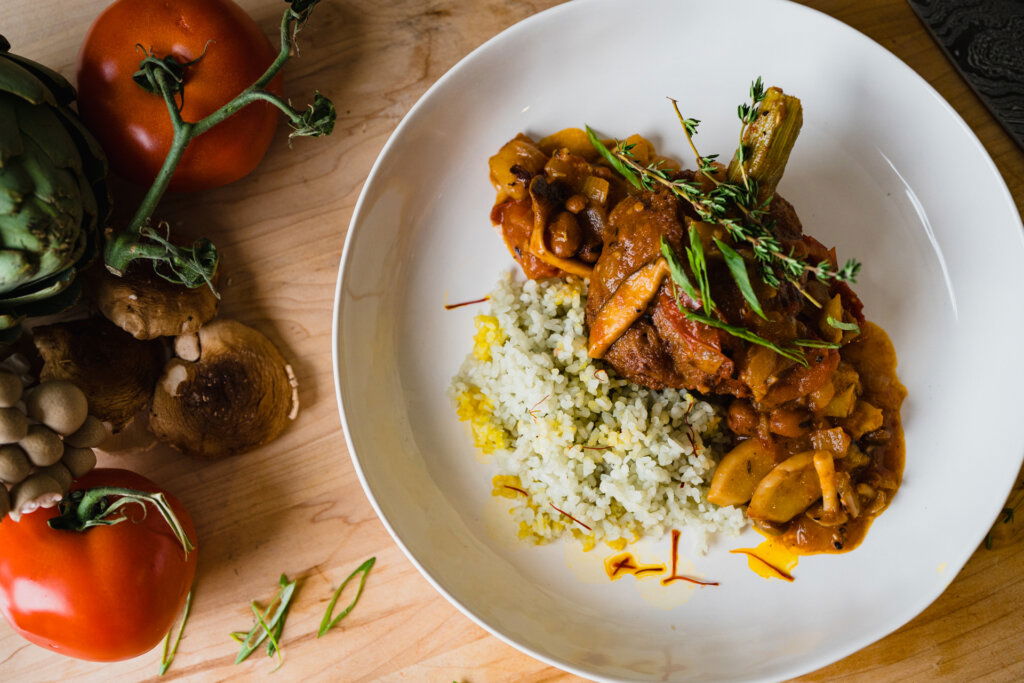

As consumers look to expand their palates with plant-based proteins, innovation and variety are the name of the game in 2022. Ingredients such as textured pea proteins, mung beans and seaweed are being utilized alongside soy to improve the taste and texture of meat analogues. Thai mushroom and jackfruit “pork” and burgers made from sunflower, fava bean and beetroot in UAE showcase this new wave of ingredient creativity.
A running theme of “better for you, better for the planet” has taken over plant-based product development, as consumer awareness of the environmental effects of the meat industry and marine ecosystem grows. In the US, whitefish made from pulses is being served at a national seafood chain, while a fast casual West Coast operation showcases vegan lamb in their souvlaki sandwiches. An Austrian startup has even developed a method for 3D printing pea- and algae-based salmon, to create a healthier and more sustainable product.
Traditional snacks are getting a plant-based makeover too, with unique items such as vegan jerky (Germany), lentil and bean pretzels (US) and mushroom crackers (Brazil) making their way onto retail shelves. Salty plant-based snacks are common in India—especially roasted, seasoned chickpeas—but an opportunity exists to expand the market with healthier options and snack-appropriate meat and dairy substitutes.
3 Trends to Watch

Technology:
3D printing, artificial intelligence and lab-grown meat will be utilized to develop a more diverse, realistic variety of plant-based offerings in the coming years.

Nutrition:
To address consumer demand for clean label claims in plant-based products, brands will find ways to innovate with more wholesome ingredients.

Sustainability:
Communicating the environmental and ethical implications of products on-pack will be just as important as nutrition and taste.

How to Make Plant-Based Osso Buco
Chef Mark Serice shares his excitement for innovation happening in the plant-based space, on both a local and a global level. Watch our latest video for a taste of the unexpected as he serves up an elevated, unique take on a classic recipe: braised gluten and artichoke osso buco.
Segment Snapshot
QSR/Foodservice:
Plant-based meat and seafood substitutes have become staples across global menus, from independent restaurants to large chains. Operators are experimenting with more advanced alternatives to steak, lamb and sushi-grade tuna.
Protein Processors:
Protein offerings extend beyond the classic plant-based burger, as brands use new ingredients and technologies to develop more varieties of “meat” such as lamb, short ribs, pork, tuna and other seafood alternatives.
Snacking:
CPG snacks are using wholesome ingredients, such as pulses and mushrooms, as bases for plant-based snacks to provide clean label, satiating options.

Culinary Inspiration
Get inspired by these on-trend concepts to create innovative offerings using Griffith Foods products.
Braised Gluten and Artichoke Osso Buco

This plant-based take on a classic—made with artichoke and vital wheat gluten dough—is braised in a ragout of mushrooms, smoked tomatoes and cannellini beans, then served over a bed of saffron-scented bamboo green tea rice.
Featuring: Griffith Foods Smoked Tomato and Mushroom Sauce Seasoning, Griffith Foods Risotto Milanese Rice Seasoning
West African Pan-Roasted Broad Beans

Broad beans with a touch of olive oil are slowly roasted over an open flame, creating a perfectly crisp exterior and mellow, smooth center. They’re dusted with a West African spice blend of onion, tomato, red pepper, rosemary and nutmeg to create a traditional flavor profile in a high-protein snack.
Featuring: Griffith Foods Jollof Snack Seasoning
Chef Tip

“When preparing plant-based meal ideas, pair ingredients with familiar flavors. Use vegan stocks made from vegetable trimmings, dried mushrooms and wakame seaweed to add a punch of umami to dried legumes, sauces and soups. Dishes such as smoked mushroom Bolognese, hearts of palm ceviche and seitan-based Peking ‘duck’ are familiar in flavor but reach new heights of creativity in their plant-based executions.”– Chef Mark Serice, Vice President Global Culinary, Griffith Foods

What’s Next for Alternative Proteins?

With the global population projected to reach 10 billion by 2050, alternative protein represents a more sustainable, environmentally friendly way of feeding the world. Plant-derived ingredients, meat analogues, fermented foods and insect protein are just some of the possibilities.
Discover how Griffith Foods is exploring these emerging ingredients, innovative processes and changing consumer preferences in our latest white paper, “Now, Next, Future.”

© 2022 Griffith Foods. All rights reserved.
Source: Mintel, 2022 FlavorIQ® Global Trends and Insights Report, January 2022.




